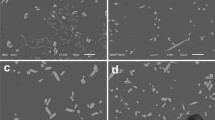Abstract
The experimental dissolution of zircon into a zircon-undersaturated felsic melt of variable water content at high pressure in the temperature range 1,020° to 1,500° C provides information related to 1) the solubility of zircon, 2) the diffusion kinetics of Zr in an obsidian melt, and 3) the rate of zircon dissolution. Zirconium concentration profiles observed by electron microprobe in the obsidian glass adjacent to a large, polished zircon face provide sufficient information to calculate model diffusion coefficients. Results of dissolution experiments conducted in the virtual absence of water (<0.2% H2O) yield an activation energy (E) for Zr transport in a melt ofM=1.3 [whereM is the cation ratio (Na+K+2Ca)/(Al·Si)] of 97.7±2.8 kcal-mol−1, and a frequency factor (D 0) of 980 +1,390−580 cm2-sec−1. Hydrothermal experiments provide an E=47.3±1.9 kcal-mol−1 andD 0=0.030 +0.030−0.015 cm2-sec−1. Both of these results plot close to a previously defined diffusion compensation line for cations in obsidian. The diffusivity of Zr at 1,200° C increases by a factor of 100 over the first 2% of water introduced into the melt, but subsequently rises by only a factor of five to an apparent plateau value of ∼2×10−9 cm2-sec−1 by ∼6% total water content. The remarkable contrast between the wet and dry diffusivities, which limits the rate of zircon dissolution into granitic melt, indicates that a 50 μm diameter zircon crystal would dissolve in a 3 to 6% water-bearing melt at 750° C in about 100 years, but would require in excess of 200 Ma to dissolve in an equivalent dry system. From this calculation we conclude that zircon dissolution proceeds geologically instantaneously in an undersaturated, water-bearing granite. Estimates of zircon solubility in the obsidian melt in the temperature range of 1,020° C to 1,500° C confirm and extend an existing model of zircon solubility to these higher temperatures in hydrous melts. However, this model does not well describe zircon saturation behavior in systems with less than about 2% water.
Similar content being viewed by others
References
Black LP, Gulson BL (1978) The age of the Mud Tank Carbonatite, Strangways Range, Northern Territory, BMR J Austr Geophys 3:227–232
Carslaw HS, Jaeger JC (1959) Conduction of heat in solids, Oxford University Press, Oxford, pp 510
Gleadow AJW (1978) Comparison of fission-track dating methods: Effects of anisotropic etching and accumulatedα-damage. US Geol Surv Open-file Report 78-701:143–145
Hart SR (1981) Diffusion compensation in natural silicates. Geochim Comochim Acta 45:279–291
Heinrich KFJ (1981) Electron beam x-ray microanalysis. Van Nostrand Reinhold, New York, pp 578
Hofmann AW (1980) Diffusion in natural silicate melts: A critical review. In: Hargraves RB (ed) Physics of Magma Processes. Princeton University Press, Princeton. 385–417
Jambon A (1982) Tracer diffusion in granitic melts: Experimental results for Na, K, Rb, Cs, Ca, Sr, Ba, Ce, Eu to 1,300° C and a model of calculation. J Geophys Res 87:10797–10810
Stolper E (1982) Water in silicate glasses: An infrared spectroscopic study. Contrib Mineral Petrol 81:1–17
Watson EB (1982) Basalt contamination by continental crust: Some experiments and models. Contrib Mineral Petrol 80:73–87
Watson EB (1981) Diffusion in magmas at depth in the earth: The effects of pressure and dissolved H2O. Earth Planet Sci Lett 52:291–301
Watson EB, Harrison TM (1983a) Zircon saturation revisited: Temperature and composition effects in a variety of crustal magma types. Earth Planet Sci Lett should indicate that it is published in volume 64, pp 295–304
Watson EB, Harrison TM (1983b) Accessory mineral phases and the geochemical evolution of crustal magmatic systems: A summary and prospectus of experimental approaches. Phys Earth Planet Int (in press)
York D (1969) Least squares fitting of a straight line with correlated errors. Earth Planet Sci Lett 5:320–324
Author information
Authors and Affiliations
Rights and permissions
About this article
Cite this article
Harrison, T.M., Watson, E.B. Kinetics of zircon dissolution and zirconium diffusion in granitic melts of variable water content. Contr. Mineral. and Petrol. 84, 66–72 (1983). https://doi.org/10.1007/BF01132331
Received:
Accepted:
Issue Date:
DOI: https://doi.org/10.1007/BF01132331




